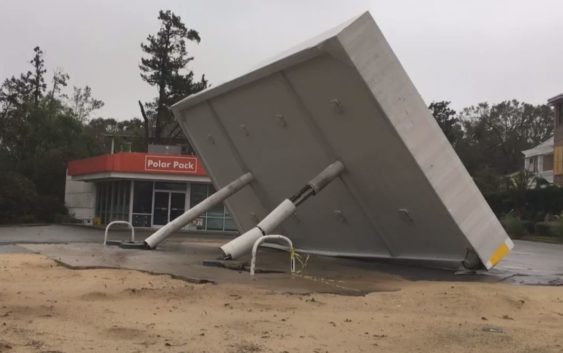- NC Gov. Stein pledges continued Hurricane Helene recovery support in 100-day address
- Austin adopts new map that greatly expands area at risk of wildfire
- CenterPoint Energy accelerates infrastructure improvements ahead of hurricane season
- Carolina Hurricanes playoff tickets go on sale Thursday
- Ask the Meteorologist: Why do tornadoes target Tornado Alley, Dixie Alley?
Florence rolls ashore in Carolinas, tears buildings apart

By JONATHAN DREW, Associated Press
WILMINGTON, N.C. (AP) — Hurricane Florence lumbered ashore in North Carolina with howling 90 mph winds and terrifying storm surge early Friday, ripping apart buildings and knocking out power to a half-million homes and businesses as it settled in for what could be a long and extraordinarily destructive drenching.
More than 60 people had to be pulled from a collapsing motel at the height of the storm, and many more who defied evacuation orders held out hope of being rescued. Pieces of torn-apart buildings flew through the air.
More ominously, forecasters said the onslaught would last for hours and hours because Florence was barely creeping along at 6 mph and still drawing energy from the ocean.
There were no immediate reports of any deaths.
Florence made landfall as a Category 1 hurricane at 7:15 a.m. at Wrightsville Beach, a few miles east of Wilmington, not far from the South Carolina line, coming ashore along a mostly boarded-up, emptied-out stretch of coastline.
Its storm surge and the prospect of 1 to 3½ feet of rain were considered a bigger threat than its winds, which dropped way down from a terrifying 140 mph — Category 4 — earlier in the week. Forecasters said catastrophic freshwater flooding is expected well inland over the next few days as Florence crawls across the Carolinas.
The National Hurricane Center said the storm will eventually push westward and make a right hook to the northeast over the southern Appalachians, moving into the mid-Atlantic region and New England as a tropical depression by the middle of next week.
Coastal streets in the Carolinas flowed with frothy ocean water, and at least 510,000 homes and businesses were without power, nearly all of them in North Carolina, according to poweroutage.us, which tracks the nation’s electrical grid.
At 9 a.m., the center of Florence was wobbling about 20 miles southwest of Wilmington, its winds down to 85 mph, according to the hurricane center. Hurricane-force winds extended 80 miles from its center, and tropical-storm-force winds reached out 195 miles.
Sheets of rain splattered against windows of a hotel before daybreak in Wilmington, where Sandie Orsa of Wilmington sat in a lobby lit by emergency lights after the power failed.
“Very eerie, the wind howling, the rain blowing sideways, debris flying,” said Orsa, who lives nearby and feared splintering trees would pummel her house.
Forecasters said Florence’s surge could cover all but a sliver of the Carolina coast under as much as 11 feet of sea water.
The rising sea crept toward the two-story home of Tom Copeland, who lives on a spit of land surrounded by water in Swansboro.
The water “is as high as it’s ever been, and waves are breaking on my point, which is normally grass,” said Copeland, a freelance photographer for The Associated Press. “Trees are blowing down in the wind. Nothing’s hit the house yet, but it’s still blowing.”
In Jacksonville, next to Camp Lejeune, firefighters and police fought wind and rain as they went door-to-door to pull people out of the Triangle Motor Inn after the cinderblock structure began to crumble and the roof started to collapse.
The Wilmington airport had a wind gust clocked at 105 mph, the highest since Hurricane Helene in 1958, the weather service said.
Farther up the coast, in New Bern, about 150 people waited to be rescued from flooding on the Neuse River, WXII-TV reported. The city said two Federal Emergency Management Agency teams were working on swift-water rescues, and more were on the way.
The worst of the storm’s fury had yet to reach coastal South Carolina, where emergency managers said it was not too late for people to get out.
“There is still time, but not a lot of time,” said Derrec Becker of the South Carolina Department of Emergency Management.
More than 12,000 people were in shelters in North Carolina and 400 in Virginia, where the forecast was less dire. Officials said some 1.7 million people in the Carolinas and Virginia were warned to evacuate, but it was unclear how many did. More than 3,000 inmates at North Carolina prisons and juvenile detention centers were moved out of the storm’s path.
Forecasters said that given the storm’s size and sluggish track, it could cause epic damage akin to what the Houston area saw during Hurricane Harvey just over a year ago, with floodwaters swamping homes and businesses and washing over industrial waste sites and hog-manure ponds.
Florence was seen as a major test for FEMA, which was heavily criticized as slow and unprepared last year for Hurricane Maria in Puerto Rico, where the storm was blamed for nearly 3,000 deaths in the desperate months that followed.
Hurricane Irma destroyed Kathy Griffin’s house in Florida last year, and it could be days before she finds out whether Florence smashed her fifth-story condominium in Wrightsville Beach, where authorities said utilities could be out for days or weeks.
“You can’t get over till we have power and we have sewer up and running,” said the retired teacher and real estate agent, who rode out the hurricane in an inland hotel.
___
Associated Press writers Seth Borenstein in Washington; Jeffrey Collins in Myrtle Beach, South Carolina; Jennifer Kay in Miami; Gary Robertson in Raleigh, North Carolina; Sarah Rankin and Denise Lavoie in Richmond, Virginia; Meg Kinnard in Columbia, South Carolina; Skip Foreman in Charlotte, North Carolina; Jeff Martin in Hampton, Georgia; David Koenig in Dallas; Gerry Broome at Nags Head, North Carolina; and Jay Reeves in Atlanta contributed to this report.